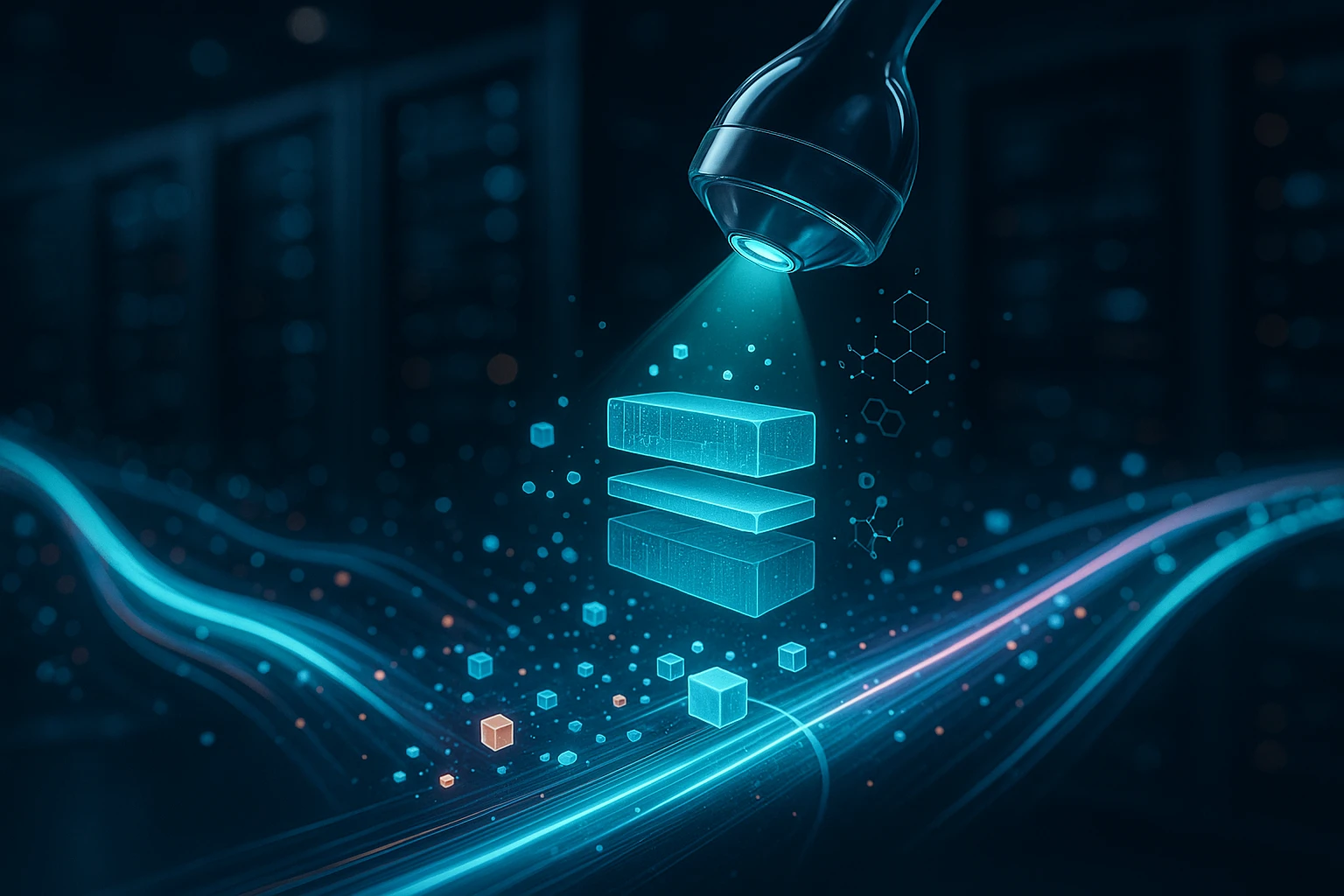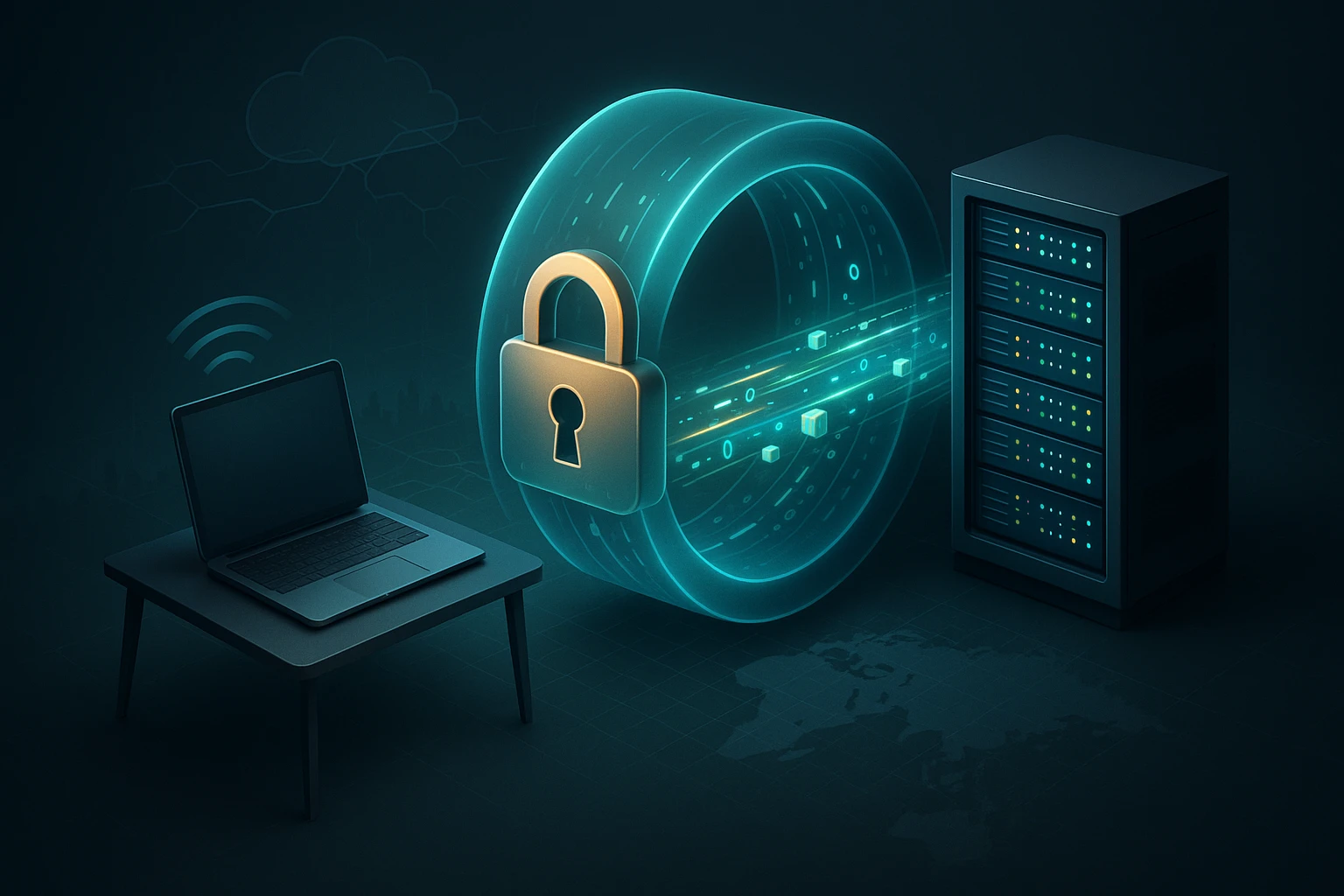What Is a DDoS Attack?
Graphics showing a DDoS attack: many compromised devices send overwhelming traffic to a target server, exhausting resources and preventing legitimate users from accessing services.

What Is a DDoS Attack?
Digital infrastructure forms the backbone of modern business, communication, and daily life. When that infrastructure falters—not through accident but through deliberate assault—the consequences ripple through organizations, communities, and economies. Understanding the mechanisms behind these digital disruptions isn't just a technical concern; it's a fundamental requirement for anyone participating in our interconnected world.
Distributed Denial of Service attacks represent a specific category of cyber aggression where attackers overwhelm target systems with artificial traffic, rendering legitimate services inaccessible. Unlike sophisticated intrusions that steal data or plant malware, these attacks operate through brute force—flooding networks, servers, or applications until they buckle under pressure. This examination explores the technical foundations, real-world implications, and defensive strategies surrounding this persistent threat.
Through detailed analysis of attack methodologies, historical incidents, economic impacts, and protective measures, you'll gain comprehensive insight into how these disruptions function, why they matter, and what organizations can do to maintain resilience. Whether you're responsible for digital infrastructure, making security investment decisions, or simply seeking to understand modern cyber threats, this exploration provides the knowledge foundation you need.
Understanding the Fundamental Mechanics
The core concept operates on a deceptively simple principle: overwhelm a target with more requests than it can handle. Imagine a popular restaurant that can serve fifty customers simultaneously. If three hundred people suddenly arrive demanding immediate service, the establishment grinds to a halt—not because anything broke, but because capacity was exceeded. Digital services face identical constraints, with finite processing power, bandwidth, and connection limits.
Traditional denial of service attempts originated from single sources, making them relatively straightforward to block. The distributed evolution changed everything. By coordinating thousands or millions of compromised devices—collectively called a botnet—attackers generate traffic volumes that dwarf what any single machine could produce. These botnets typically consist of infected computers, smartphones, Internet of Things devices, and servers whose owners remain unaware their equipment participates in attacks.
"The asymmetry is striking: launching an attack costs pennies per hour through rental services, while defending against sustained assaults can cost thousands daily in mitigation services and lost revenue."
Attack traffic appears superficially legitimate, complicating defensive efforts. Distinguishing between authentic users and malicious bots requires sophisticated analysis, especially when attackers deliberately mimic normal behavior patterns. Some attacks exploit protocol weaknesses, where small requests trigger disproportionately large responses, amplifying the attacker's effective bandwidth. Others target specific application vulnerabilities, requiring minimal traffic to exhaust critical resources like database connections or processing threads.
Primary Attack Vectors and Classifications
Security professionals categorize these assaults into three fundamental types, each exploiting different aspects of network infrastructure:
- Volumetric attacks flood network bandwidth with massive data quantities, consuming all available transmission capacity between the target and the broader internet. These represent the most common approach, accounting for the majority of incidents.
- Protocol attacks exploit weaknesses in network layer protocols, exhausting server resources, firewalls, or load balancers through malformed packets or connection manipulation. These attacks target infrastructure equipment rather than bandwidth.
- Application layer attacks focus on web applications themselves, sending seemingly legitimate requests that consume server resources through expensive database queries, file operations, or computational processes. These sophisticated attacks require less traffic but prove harder to detect.
Modern campaigns frequently combine multiple vectors simultaneously, forcing defenders to address threats across different infrastructure layers. An attacker might launch volumetric floods to distract security teams while simultaneously executing targeted application attacks against critical services. This multi-vector approach significantly complicates mitigation efforts and increases the likelihood of successful disruption.
Historical Context and Evolution
Early instances emerged in the late 1990s as relatively crude affairs, with attackers manually coordinating small numbers of compromised machines. The landscape transformed dramatically as broadband adoption accelerated and malware became more sophisticated. By the mid-2000s, organized criminal groups recognized the profit potential, developing botnet rental services that democratized access to attack capabilities.
Several landmark incidents demonstrated escalating scale and sophistication. The 2016 Dyn attack leveraged the Mirai botnet—composed primarily of compromised security cameras and home routers—to disrupt major internet platforms including Twitter, Netflix, and Reddit. Peak traffic exceeded one terabit per second, a staggering volume that highlighted vulnerabilities in Internet of Things devices with minimal security protections.
| Year | Notable Incident | Peak Traffic | Primary Target | Significance |
|---|---|---|---|---|
| 2013 | Spamhaus Attack | 300 Gbps | Anti-spam organization | First major DNS amplification attack demonstrating new techniques |
| 2016 | Dyn DNS Attack | 1.2 Tbps | DNS infrastructure provider | Exposed IoT device vulnerabilities, disrupted major internet services |
| 2018 | GitHub Attack | 1.35 Tbps | Code repository platform | Largest recorded memcached amplification attack |
| 2020 | AWS Attack | 2.3 Tbps | Amazon Web Services | Current record holder, demonstrated CLDAP reflection capabilities |
| 2022 | Cloudflare Mirai Variant | 26 million requests/second | Financial services customer | Largest application layer attack recorded |
Attack motivations have diversified considerably. While early incidents often represented technical demonstrations or ideological "hacktivism," contemporary campaigns serve varied purposes: extortion attempts demanding cryptocurrency payments, competitive sabotage between business rivals, geopolitical conflicts extending into cyberspace, and diversionary tactics masking concurrent data theft operations. The attack-for-hire economy has matured, with professional services offering guaranteed disruption at surprisingly affordable rates.
"Detection capabilities have improved dramatically, yet attackers continuously adapt their techniques, creating an endless cycle where defensive innovations spawn new offensive approaches within months."
Technical Implementation and Infrastructure
Building attack capabilities requires establishing control over numerous devices. Cybercriminals typically achieve this through malware distribution—exploiting software vulnerabilities, tricking users into installing infected applications, or conducting brute-force attacks against devices with default credentials. Once compromised, devices become botnet members awaiting commands from central controllers.
Command and control infrastructure has evolved to resist takedown efforts. Early botnets relied on centralized servers that, once identified, could be seized or blocked to neutralize the entire network. Modern variants employ peer-to-peer architectures where compromised devices communicate directly, eliminating single points of failure. Some leverage blockchain technology or legitimate cloud services to hide command channels within normal internet traffic.
Amplification and Reflection Techniques
Sophisticated attackers exploit internet protocols that allow small requests to generate large responses. DNS, NTP, SNMP, and memcached services all possess characteristics attackers abuse for amplification. The process involves sending requests to vulnerable servers while spoofing the source address to appear as though they originated from the target. Servers then send their responses—often fifty to one hundred times larger than the initial request—to the victim.
This approach provides multiple advantages: attackers need minimal bandwidth themselves, the attack traffic originates from legitimate servers making blocking difficult, and the true attack source remains obscured. Reflection attacks have generated some of the largest recorded traffic volumes, with amplification factors exceeding 50,000x in extreme cases.
Business and Economic Impact
Organizations face immediate revenue loss when customer-facing services become unavailable. E-commerce platforms lose sales directly, while service providers face contract penalties for violating availability guarantees. The financial impact extends beyond immediate downtime—customer trust erodes, competitors capture market share, and brand reputation suffers lasting damage that persists long after services restore.
Mitigation costs compound the damage. Enterprise-grade protection services charge thousands monthly for baseline coverage, with additional fees during active attacks based on traffic volume. Organizations lacking advance preparation face emergency procurement at premium rates while simultaneously managing the crisis. Technical staff require overtime compensation, executive attention diverts from strategic initiatives, and post-incident analysis consumes additional resources.
| Cost Category | Small Business | Mid-Size Enterprise | Large Corporation | Contributing Factors |
|---|---|---|---|---|
| Direct Revenue Loss | $8,000 - $74,000 | $120,000 - $540,000 | $1M - $5M+ | Hourly transaction volume, customer base size, service criticality |
| Mitigation Services | $2,000 - $10,000 | $15,000 - $50,000 | $100,000 - $500,000 | Attack duration, traffic volume, service tier, contract terms |
| Recovery Operations | $5,000 - $20,000 | $30,000 - $100,000 | $200,000 - $800,000 | Staff overtime, consultant fees, emergency procurement |
| Reputation Damage | $10,000 - $50,000 | $100,000 - $500,000 | $2M - $10M+ | Customer churn, brand perception, competitive positioning |
| Legal and Regulatory | $3,000 - $15,000 | $25,000 - $150,000 | $500,000 - $3M | Contract penalties, compliance violations, lawsuit defense |
"Small organizations often suffer disproportionately because they lack dedicated security teams and cannot absorb sudden five-figure mitigation expenses without significant financial strain."
Certain industries face heightened vulnerability. Financial services must maintain constant availability for transaction processing. Healthcare providers cannot tolerate disruptions to patient care systems. Gaming platforms lose players to competitors during outages. Media organizations become targets during major events when viewership peaks. Government agencies face attacks timed to coincide with elections, policy announcements, or geopolitical tensions.
Detection and Early Warning Signs
Recognizing attacks quickly minimizes damage, yet early detection presents challenges. Initial symptoms often resemble legitimate traffic spikes or technical issues. Website slowdowns might indicate server problems, network congestion, or the beginning of an assault. Distinguishing between these scenarios requires monitoring systems that establish performance baselines and alert on anomalies.
🔍 Key indicators that warrant immediate investigation include sudden traffic increases from unexpected geographic regions, unusual patterns in request types or timing, spikes in failed connection attempts, and disproportionate bandwidth consumption relative to completed transactions. Network equipment logs showing resource exhaustion—CPU maxed out, memory depleted, connection tables full—provide additional confirmation.
Sophisticated monitoring examines traffic characteristics beyond volume. Legitimate users exhibit varied behavior patterns: different browsers, operating systems, navigation paths, and timing. Attack traffic often shows suspicious uniformity—identical user agents, sequential IP addresses, perfectly timed requests, or requests for non-existent resources. Machine learning systems trained on normal traffic patterns can identify these anomalies with increasing accuracy.
Response Protocols and Incident Management
Organizations need predetermined response plans rather than improvising during crises. Effective protocols designate clear authority chains, establish communication channels, define escalation criteria, and document technical procedures. When attacks commence, coordinated responses prove far more effective than ad-hoc reactions.
Initial response focuses on confirming the attack and assessing scope. Is this affecting all services or specific applications? What traffic volume are we seeing? Where does the traffic originate? Are there multiple attack vectors? This assessment informs subsequent decisions about mitigation strategies and resource allocation.
Defense Strategies and Mitigation Techniques
Effective protection requires layered defenses addressing different attack types and infrastructure levels. No single solution provides complete protection; comprehensive security combines multiple approaches that complement each other's strengths and compensate for weaknesses.
🛡️ Network infrastructure hardening forms the foundation. Redundant internet connections through diverse providers prevent single points of failure. Bandwidth reserves above normal requirements provide headroom to absorb traffic spikes. Rate limiting restricts how many requests individual sources can make. Firewalls configured with anti-DDoS rules filter obviously malicious traffic before it reaches applications.
Content delivery networks distribute traffic across geographically dispersed servers, making it harder to overwhelm any single location. When attacks target specific regions, traffic can route through unaffected areas. CDNs also cache static content, reducing load on origin servers and allowing them to focus resources on dynamic requests that require database access or computation.
"The most resilient organizations treat DDoS protection as ongoing operational requirements rather than one-time projects, continuously testing defenses and updating strategies as threats evolve."
Specialized Mitigation Services
Cloud-based scrubbing services provide industrial-scale defense capabilities that most organizations cannot build internally. These services route traffic through massive filtering infrastructure that analyzes requests, blocks malicious traffic, and forwards legitimate requests to protected destinations. Leading providers maintain global networks with multi-terabyte capacity, sufficient to absorb even record-breaking attacks.
Scrubbing services operate through several deployment models. Always-on configurations route all traffic through protection infrastructure continuously, providing immediate defense but adding latency and ongoing costs. On-demand activation redirects traffic only during attacks, minimizing costs and latency but requiring time to activate and propagate routing changes. Hybrid approaches balance these tradeoffs based on specific requirements.
⚡ Application layer protection requires different approaches than network-level defense. Web application firewalls analyze HTTP requests for malicious patterns, blocking SQL injection attempts, cross-site scripting, and application-specific attacks. Rate limiting at the application level prevents individual users or IP addresses from monopolizing resources. CAPTCHA challenges distinguish human users from bots during suspicious activity.
Legal and Ethical Dimensions
Launching these attacks violates laws in virtually all jurisdictions, typically categorized as computer fraud, unauthorized access, or cybercrime. Penalties range from fines to imprisonment, with sentences increasing based on damage severity and target sensitivity. Despite legal prohibitions, prosecution remains challenging due to international jurisdictional complexities and attacker anonymization techniques.
Victims face difficult decisions about response approaches. Law enforcement notification is advisable but rarely produces immediate relief. Paying extortion demands might seem expedient but encourages future attacks and funds criminal enterprises. Public disclosure risks reputation damage but may be required by regulatory frameworks or contractual obligations.
Attribution—determining who launched an attack—presents significant challenges. Attackers route traffic through compromised devices and use techniques that obscure their true location. Even when technical indicators point to specific regions or groups, definitive attribution requires intelligence beyond what most organizations possess. Nation-state actors possess sophisticated capabilities that further complicate identification efforts.
Emerging Threats and Future Trends
The threat landscape continues evolving as technology advances and attackers innovate. Several trends warrant particular attention from security professionals and organizational leadership.
🌐 Internet of Things devices proliferate rapidly, with billions of connected cameras, thermostats, appliances, and sensors deployed with minimal security. Many ship with default credentials never changed by owners, making them trivial to compromise. As 5G networks enable even more connected devices with higher bandwidth, the potential botnet capacity grows exponentially.
Artificial intelligence and machine learning enhance both attack and defense capabilities. Attackers employ AI to identify vulnerable targets, optimize attack parameters, and adapt techniques in real-time based on defender responses. Defenders leverage machine learning for anomaly detection, traffic analysis, and automated response. This creates an escalating technological arms race where advantages prove temporary.
"The next generation of attacks will likely target emerging technologies like edge computing infrastructure and 5G network slicing, exploiting vulnerabilities before defensive best practices mature."
Ransom attacks have evolved beyond data encryption to include DDoS threats. Attackers demand payment to prevent or cease disruption, sometimes combining encryption and denial of service simultaneously. This dual-threat approach increases pressure on victims and likelihood of payment. Some criminal groups now specialize in DDoS extortion, conducting reconnaissance to identify vulnerable targets and calibrating demands based on victim revenue estimates.
Preparing for Tomorrow's Challenges
Organizations must adopt forward-looking security strategies that anticipate emerging threats rather than merely responding to current ones. This requires ongoing investment in defensive capabilities, regular testing through simulated attacks, and continuous education for technical staff and leadership.
Threat intelligence sharing between organizations, industry groups, and government agencies helps everyone defend more effectively. When one organization identifies new attack techniques or indicators, sharing that information allows others to prepare defenses proactively. Public-private partnerships have developed frameworks for responsible information exchange while protecting sensitive details.
💡 Building organizational resilience extends beyond technical measures to include business continuity planning, incident response procedures, and stakeholder communication strategies. Organizations that document their critical dependencies, maintain updated contact lists, and practice response scenarios recover faster and with less damage than those improvising during crises.
Practical Implementation Guidance
Organizations at any scale can take concrete steps to improve their defensive posture. The specific measures appropriate for your situation depend on factors including industry, size, risk tolerance, and existing infrastructure, but certain principles apply universally.
Begin with comprehensive asset inventory. You cannot protect what you don't know exists. Document all internet-facing services, their dependencies, traffic patterns, and business criticality. This inventory informs prioritization decisions and helps identify single points of failure that require redundancy or additional protection.
Establish baseline performance metrics for normal operations. Monitor request rates, bandwidth utilization, server resource consumption, and response times. These baselines enable anomaly detection and help distinguish attacks from legitimate traffic spikes. Modern monitoring tools can track hundreds of metrics simultaneously and apply statistical analysis to identify deviations.
Vendor Selection and Service Evaluation
Choosing mitigation services requires careful evaluation beyond marketing claims. Consider the provider's network capacity, geographic coverage, detection capabilities, activation speed, and customer support quality. Request references from similar organizations and inquire about their experiences during actual attacks.
🔧 Evaluate technical capabilities specifically relevant to your infrastructure. Does the service protect the protocols and application types you use? Can it handle your peak legitimate traffic without performance degradation? What visibility and control do you retain during mitigation? How does traffic routing work, and what latency does it introduce?
Contract terms deserve scrutiny beyond pricing. Understand exactly what traffic volumes are included, how overage charges work, what constitutes an "attack" for billing purposes, and what service level agreements guarantee. Some providers charge per incident while others offer unlimited protection; neither model is inherently superior, but the right choice depends on your specific risk profile.
Building Internal Capabilities
While specialized services provide essential protection, internal capabilities remain crucial. Staff need training to recognize attacks, execute response procedures, and coordinate with external providers. Regular drills ensure everyone understands their roles and can execute under pressure.
Documentation proves invaluable during incidents when stress levels run high and memory fails. Maintain updated runbooks covering detection procedures, escalation paths, vendor contact information, technical mitigation steps, and communication templates. Test these documents periodically and update them based on lessons learned from drills or actual incidents.
Cross-functional coordination between security, network operations, application development, and business leadership prevents siloed responses where different teams work at cross purposes. Establish clear communication channels and ensure all stakeholders understand how attacks impact business operations and what their specific responsibilities include.
Industry-Specific Considerations
Different sectors face unique challenges that require tailored approaches. Financial institutions must maintain transaction processing availability while meeting stringent regulatory requirements. Healthcare organizations cannot tolerate disruptions to patient care systems and face HIPAA compliance obligations. E-commerce platforms lose revenue directly during outages and face intense competitive pressure.
Government agencies represent high-profile targets with symbolic value to ideologically motivated attackers. Educational institutions often have complex networks with numerous entry points and limited security budgets. Media organizations face attacks timed to major events when disruption causes maximum impact. Each sector must assess its specific risk profile and implement appropriate controls.
"Generic security approaches rarely address industry-specific vulnerabilities effectively; organizations must understand their unique threat landscape and tailor defenses accordingly."
Cost-Benefit Analysis and Risk Management
Security investments compete with other organizational priorities for limited resources. Executives rightfully demand justification for expenditures, requiring security professionals to articulate risks in business terms and demonstrate return on investment.
Quantitative risk assessment provides a framework for these decisions. Estimate the probability of attacks based on industry data and your specific threat profile. Calculate potential impact including direct revenue loss, mitigation costs, recovery expenses, and reputation damage. Compare this expected loss against prevention costs to determine appropriate investment levels.
🎯 Remember that perfect security proves neither achievable nor economically rational. The goal is reducing risk to acceptable levels given your specific circumstances. A small business cannot justify enterprise-grade protection costing more than potential losses, while a major financial institution must invest heavily given their risk exposure and regulatory obligations.
Regulatory Compliance and Reporting Requirements
Various regulatory frameworks impose requirements related to availability, incident reporting, and customer notification. Payment card industry standards mandate specific security controls for merchants processing credit cards. Healthcare regulations require protecting patient data availability. Financial services face numerous requirements from multiple regulatory bodies.
Understanding applicable requirements prevents compliance violations that compound attack damage with regulatory penalties. Some jurisdictions require notifying authorities within specific timeframes after detecting incidents. Others mandate customer notification when personal information might be affected. Failure to meet these obligations can result in fines, sanctions, or legal liability.
Compliance should be viewed as a baseline rather than a ceiling. Regulatory requirements typically represent minimum acceptable standards, not comprehensive security programs. Organizations should implement controls appropriate to their actual risk profile even when regulations don't explicitly require them.
The Human Element in Defense
Technology alone cannot solve security challenges; human factors prove equally important. Security awareness training helps all employees recognize threats and respond appropriately. Developers need education about secure coding practices that minimize application vulnerabilities. Operations staff require training on security tools and incident response procedures.
Leadership commitment determines whether security receives adequate resources and organizational priority. When executives treat security as a compliance checkbox rather than operational necessity, defensive capabilities suffer. Conversely, when leadership understands risks and supports security initiatives, organizations build robust defenses that adapt to evolving threats.
🌟 Culture matters tremendously. Organizations where security is everyone's responsibility rather than solely the security team's concern develop stronger overall postures. Encouraging reporting of suspicious activity without fear of blame, rewarding security-conscious behavior, and making security part of performance evaluations all contribute to more resilient organizations.
Recovery and Post-Incident Activities
Once attacks subside and services restore, the incident response process continues. Post-mortem analysis identifies what worked well, what failed, and what requires improvement. This analysis should examine technical defenses, response procedures, communication effectiveness, and decision-making processes.
Document lessons learned while details remain fresh. What indicators first suggested an attack? How long did detection take? Were response procedures followed? Did they work as intended? What unexpected challenges emerged? How effective were external vendors? What would you do differently next time?
Implement improvements identified through post-incident analysis. Update detection rules based on attack characteristics. Revise response procedures to address gaps. Enhance monitoring to catch similar attacks faster. Conduct additional training on areas where performance fell short. Organizations that learn from incidents build progressively stronger defenses.
International Cooperation and Information Sharing
These threats transcend national boundaries, requiring international cooperation for effective response. Attackers operate from jurisdictions with limited law enforcement capabilities or political will to prosecute cybercrime. Botnets span continents, with command servers in one country, compromised devices in dozens of others, and victims anywhere.
Information sharing initiatives help organizations defend collectively rather than individually. Industry groups facilitate sharing attack indicators, techniques, and defensive strategies. Government agencies coordinate with private sector partners to identify threats and disrupt attack infrastructure. International law enforcement agencies collaborate on investigations and prosecutions.
Participating in these communities provides access to threat intelligence that improves your defensive capabilities while contributing to collective security. Many organizations hesitate to share information about attacks they experience, fearing reputation damage. However, responsible disclosure frameworks allow sharing technical details without publicly acknowledging victimization.
Balancing Security and Usability
Security measures inevitably create friction for legitimate users. Aggressive rate limiting might block real customers during peak traffic. CAPTCHA challenges frustrate users and reduce conversion rates. Geo-blocking prevents access from regions where you have legitimate customers. Finding the right balance requires understanding your user base and business requirements.
Implement security controls with appropriate granularity. Rather than blanket restrictions, apply stricter controls to sensitive functions while keeping general access relatively frictionless. Use risk-based authentication that increases verification requirements when suspicious indicators appear but remains transparent during normal usage patterns.
Monitor how security measures affect user experience and business metrics. If conversion rates drop significantly after implementing new controls, investigate whether security benefits justify the business impact. Sometimes less restrictive approaches with slightly higher risk prove more appropriate than maximum security that drives customers away.
Vendor and Supply Chain Security
Your security posture depends partially on vendors and service providers. Cloud hosting providers, content delivery networks, DNS services, and application frameworks all influence your vulnerability to attacks. Evaluate vendors' security capabilities and track records before establishing dependencies.
Understand how vendor security incidents could affect your operations. If your DNS provider suffers an attack, can customers reach your services? If your hosting provider's network gets overwhelmed, what happens to your applications? Identify critical dependencies and establish redundancy or backup arrangements where practical.
Contractual provisions should address security responsibilities, incident notification requirements, and liability allocation. Who pays mitigation costs if an attack targets your vendor but affects your services? What service level agreements apply during attacks? How quickly will the vendor notify you of incidents? Clear contractual terms prevent disputes during crises.
Long-Term Strategic Planning
Effective security requires sustained commitment rather than one-time initiatives. Threat landscapes evolve continuously, requiring ongoing adaptation. Technology changes, attack techniques advance, and business requirements shift. Security programs must evolve accordingly or gradually become obsolete.
Develop multi-year security roadmaps aligned with business strategy. As your organization grows, enters new markets, or launches new services, security requirements change. Plan capability development, budget allocation, and staffing needs to match anticipated requirements rather than constantly reacting to immediate pressures.
Regular assessments measure security program effectiveness and identify improvement opportunities. Third-party audits provide objective evaluation and fresh perspectives. Penetration testing identifies vulnerabilities before attackers exploit them. Tabletop exercises evaluate incident response capabilities without the chaos of actual attacks.
How long do these attacks typically last?
Duration varies dramatically based on attacker motivation and resources. Some attacks last only minutes as brief demonstrations or tests, while others persist for days or weeks. Extortion attempts often involve short initial attacks demonstrating capability, followed by sustained assaults if demands aren't met. The average attack duration has decreased over time as detection and mitigation improve, with most incidents now resolved within hours rather than days.
Can small businesses afford adequate protection?
Small organizations can implement effective defenses within reasonable budgets by focusing on high-value controls and leveraging cloud-based services. Many hosting providers include basic protection, content delivery networks offer affordable plans with DDoS mitigation, and cloud-based scrubbing services provide pay-as-you-go options. While small businesses cannot match enterprise-grade defenses, layered approaches combining multiple affordable services provide meaningful protection against most attacks.
What should I do if I receive an extortion threat?
Do not immediately pay demands, as this encourages future attacks and provides no guarantee attackers will cease. Instead, notify law enforcement, activate your incident response plan, and engage your mitigation service provider. Many extortion threats prove empty, with attackers lacking capability to execute promised attacks. Even when attacks materialize, prepared organizations with proper defenses can weather them more cost-effectively than paying ransoms.
How can I tell if my organization is under attack right now?
Key indicators include sudden performance degradation, unusually high traffic volumes, increased failed connection attempts, and resource exhaustion on servers or network equipment. Monitoring tools showing traffic patterns, geographic distribution, and request characteristics help distinguish attacks from legitimate load. If you suspect an attack but lack monitoring systems to confirm, contact your hosting provider or internet service provider for assistance analyzing traffic patterns.
Are certain times of year riskier than others?
Attack frequency often increases during major shopping periods like Black Friday and holiday seasons when disruption causes maximum damage to retailers. Political events including elections see increased activity against government and media targets. Gaming platforms face heightened risk during major tournament events. However, attacks occur year-round, and organizations should maintain defenses continuously rather than only during perceived high-risk periods.
What legal recourse do victims have against attackers?
Victims can pursue criminal prosecution through law enforcement and civil litigation for damages. However, practical challenges limit effectiveness: attackers often operate from jurisdictions with limited cooperation, use anonymization techniques that complicate identification, and may lack assets to satisfy judgments even if successfully sued. Despite these limitations, reporting incidents to authorities remains important for intelligence gathering and potential future prosecution if attackers are eventually identified.




